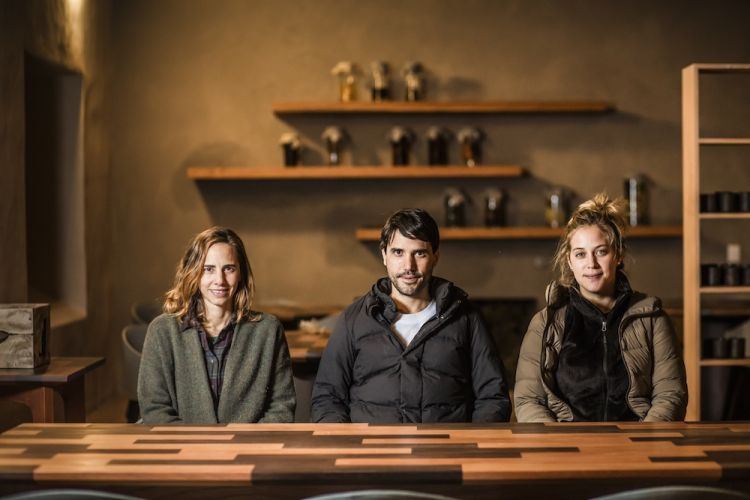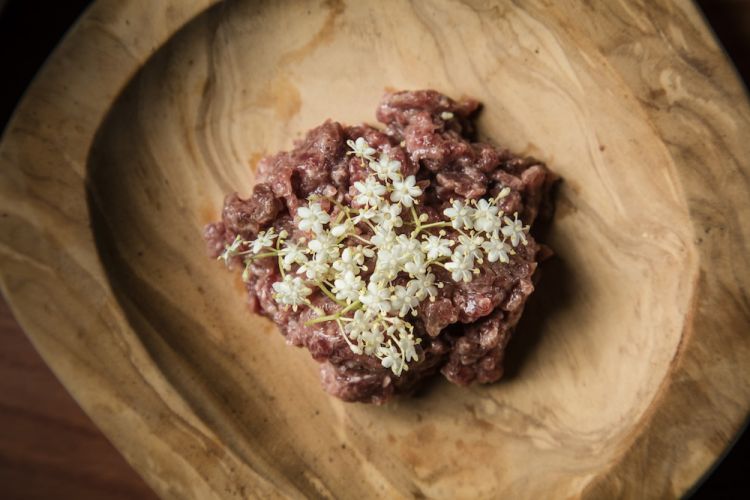Mil, chef Virgilio Martinez’s restaurant in Cusco, is Spanish for 1,000—thousands of meters in altitude, thousands of herbs, thousands of ingredients and thousands of stories. Here, Martinez tells the tales of the Andes and its people through eight “moments” centered around the region’s bounty and its traditions.
The journey to Mil is thrilling in and of itself—the winding road ascends out of Cusco and the eucalyptus-tree-studded landscape slowly but surely transforms into undulating landscapes that resemble a patchwork quilt in shades of red, green, brown and purple that stretches to meet the foot of the majestic peaks of the Andes. We turn into the town of Maras and steer through a warren of narrow bumpy lanes lined with two-story mud-brick houses affixed with azure doors. Finally, we turn onto a windy red-dirt road, honking at each and every sharp turn to make our presence known to any oncoming traffic.
We pull up to the Moray Archaeological Complex then veer left up one final hill to arrive at a mud-brick house crowned with a shaggy ichu roof standing at an altitude of 11,706 feet overlooking the Moray site, a mesmerizing series of concentric terraces constructed by the Incas.

Malena Martínez, Virgilio Martínez and Pia León
A charming staff member takes me on a tour of the facility, which is centered around an open courtyard that’s home to a Queñual tree, an emblem of the high Andes, and a garden harvesting quinoa, kiwicha, muña, potatoes, chijchipa and spearmint. In the entryway, I pass rows of dehydrated herbs dangling upside-down—fastened as such to keep the flavors intact—to arrive at the Mater Iniciativa, a research lab helmed by Martinez’s sister Milena that’s at the core of Central, his Lima restaurant, as well as a fundamental of Mil.
I immediately recognize the black and white freeze-dried chuño potatoes and the yellow-red tomato fruit shaped like an oblong tear from my recent travels, while the cushuro, tiny green orbs of algae sourced from lagoons in the high Andes, I recognize from Netflix. Others, such as the flying potato resembling a colossal chanterelle, I don’t recognize at all. Next, we visit the in-house chocolate lab where the team is experimenting with a 72% cacao bar that’s filled with actual cocoa nibs. The final stop is a shelf displaying macerations, distillations and fermentations in a plethora of jewel tones that include several iterations of tik’a tik’a, a digestive plant that grows in the highest peaks of the Peruvian Andes.
At Central, Martinez serves a 16-course tasting menu that highlights Peru’s diverse ecosystems and altitudes—the World’s 50 Best named Central the best restaurant in Latin America and sixth-best overall. At Mil, Martinez hones in on Andean cuisine, collaborating with local Kacllaraccay and Mullak’as Misminay farming communities to celebrate and chronicle local foods and traditions as well as to revive customs and practices that have fizzled out over time. My moments kick off with Preservation in honor of the freeze-dried preserved potatoes on which Andean dwellers subsisted during the winter. It consists of crisps made from the black and white dehydrated potatoes; uchucuta, a zesty tomato-fruit-based sauce; and bread made from cocoa leaf and the uca tuber that seems to magically absorb the accompanying elderflower butter.

Diversity of Corn pays tribute to one of Peru’s most prolific crops and is complete with an anecdote about how one always shares his or her crops with those who lend a hand during the harvest. Three colorful crisps made from chullpi, piscorunto and teresa corns are accompanied by a bowl of large white choclo corn kernels as well as a soft smoky cheese that’s been grilled over an open flame and served atop a bed of corn leaves.
The cushuro appear during Extreme Altitude, served in a salad of red and black quinoa and dehydrated leaves accompanied by a bowl of stewed duck and whole-grain wheat—a winning combo when mixed together. Central Andes pays homage to an Andean tradition called the huatia, a clay earthen oven in which part of the harvest was cooked as a way to say thanks and celebrate Pachamama, the highest Andean divinity. Native potatoes are served in huatia-shaped dishes made of Chaco, an edible clay consumed daily for digestion in the Puno region.
I won’t spoil the rest of the meal (you’ll just have to check out Mil for yourself), so I cap my lunch with coffee from Three Monkeys, a Cusco-based company that works with several coffee-producing families in Quillabamba (the high jungle region), that’s elaborately presented and prepared via the V60 method.
During the ride to
Mil, I didn’t even notice the restaurant nestled cozily into its hilltop perch, and I thought this was simply because I didn’t know where to look. As we head back to Cusco, I keep my eyes on
Mil from the passenger seat and watch it fade slowly into its sublime surroundings. The exterior blends right in like camouflage as I admire one of the region’s thousands of breathtaking landscapes—one that just so happens to be a testament to
Mil’s solidarity with its profound territory.